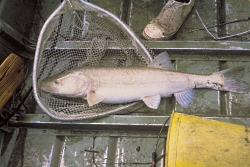
Colorado Pikeminnow
Ptychocheilus lucius
Image courtesy US FWS,
J.E. Johnson, Photographer
One of the largest minnows in the world, the Colorado pikeminnow was once found throughout the Colorado River basin. This is no bait minnow. Also known as the Colorado squawfish, it reputedly grew to a whopping 6 feet in length with a weight topping 80 pounds and a life span of 40 years. The largest caught in recent times have been only 3 feet long and 9 pounds.
Colorado pikeminnows once flourished throughout the Colorado River and most of its major tributaries. Historically, these abundant, torpedo-shaped fish were prized for their fine flavor. They were an important food fish for Native Americans and welcomed at restaurants as far away as San Francisco. Also called white salmon by early settlers due to their migratory behavior, pikeminnows journeyed 200 miles to spawn in turbid backwaters.
Then we built dams which blocked the migratory runs of pikeminnows. Below the Grand Canyon, the last wild Colorado pikeminnow was caught in 1976. The proliferation of dams has drastically restricted their range. Moreover, reservoirs flood what was suitable river habitat, and their dams alter river flows and water temperature downstream.
The Colorado pikeminnow was one of the first fish given full protection under the Endangered Species Act in 1973. Today, there are two remaining wild populations. One resides in the upper reaches of the Colorado river system, the other in the Green River system. Efforts underway to restock Colorado pikeminnow in the San Juan River basin appear to be successful.
A broadly based coalition of partners established the Upper Colorado River Endangered Fish Recovery Program in 1988. This program focuses on 4 species of fish: humpback chub, bonytail, Colorado pikeminnow and razorback sucker. Their goal is to restore and manage stream flows and habitat, reduce competition from some non-native fish species and increase populations using hatchery raised young. If they are successful, this giant piscine predator will once again take its rightful place in the upper Colorado River ecosystem.
This is Linda Kervin for Bridgerland Audubon Society.
Credits:
Photos: Courtesy US FWS, images.fws.gov
Theme: Courtesy & Copyright Don Anderson Leaping Lulu
Text & Voice: Linda Kervin, Bridgerland Audubon Society
Additional Reading:
Other Wild About Utah Pieces by Linda Kervin
Colorado Pikeminnow, Wikipedia, wikipedia.org/wiki/Colorado_pikeminnow
Researchers Capture Fourth Largest Endangered Colorado Pikeminnow in San Juan River Since 1991, US Fish & Wildlife Service, December 13, 2010, https://www.fws.gov/mountain-prairie/pressrel/10-84.htm [Link Updated December 2023]
Colorado pikeminnow (Ptychocheilus lucius), Upper Colorado River Endangered Fish Recovery Program, 2012, https://www.coloradoriverrecovery.org/general-information/the-fish/colorado-pikeminnow.html [Link Updated December 2023]
Colorado Pikeminnow, Nevada Department of Wildlife, Formerly held at https://www.ndow.org:80/wild/animals/facts/fish_colorado_pike_minnow.shtm [Not working December 4, 2023]
Colorado Pikeminnow, Species, Utah Division of Wildlife Resources, https://fieldguide.wildlife.utah.gov/?species=ptychocheilus%20lucius [Link Updated December 2023]
https://wildlife.state.co.us/Fishing/SpeciesID/Pages/FishID.aspx [Not working December 4, 2023]
https://wildlife.utah.gov/fishing/nonnative/endangeredfishfacts.pdf [Not working December 4, 2023]
Colorado Pikeminnow endangered in Carbon, Daggett, Emery, Garfield, Grand, San Juan, Unitah and Wayne Counties, Utah’s Species of Greatest Conservation Need Species by County,
https://wildlife.utah.gov/pdf/WAP/utah-sgcn-list-by%20county-10-23.pdf
